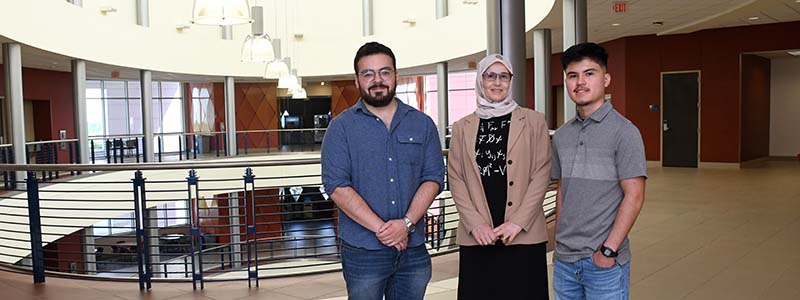CERN interns chase impossible to find possible

Raul Diaz and Estevan Salinas pinched themselves.
One moment, they had been sitting in a physics classroom. The next, unpacking luggage in a Saint-Genis-Pouilly apartment on the France/Switzerland border, with the Jura Mountains spanning the horizon.
Neither had expected to globetrot, much less join research at CERN, the European Council for Nuclear Research in Geneva. Now the two San Jacinto College students would be contributing to groundbreaking particle physics research alongside graduate students.
Going global

Since 1954, CERN has brought together the world’s top physicists and engineers to study subatomic particles using complex particle accelerators and detectors. Thanks to San Jac physics professor Dr. Laria Redjimi, San Jac is the only community college nationwide sending students to CERN. Beyond contributing to CERN physics experiments herself, Redjimi advises students and runs the internship together with Rice University faculty.
“Not only do our students explore amazing science, discussions, and critical thinking that have advanced the field of physics for decades now, but they also form a very rich network among brilliant scientists in a multidisciplinary, multicultural environment in Geneva,” she said.
What made Diaz and Salinas stand out as applicants? Redjimi says motivation, teamwork, and curiosity.
“I didn’t know what or who CERN was,” Salinas said. “But when I looked it up and saw that it was the European Council for Nuclear Research, I said, ‘I need to go!’”
Diaz knew about CERN, give or take some sci-fi. He pictured “this world-impacting, massive machine” opening portals and channeling currents into a mad scientist-type experiment.
“Having the chance to set foot in one of the most prestigious facilities in the field of particle physics would be a miracle, breaking the mold for my family,” he said.
Exploring new realms
Joining the Compact Muon Solenoid experiment as technical students in spring 2023, Diaz and Salinas helped with eco-gas and aging studies of the Gas Electron Multiplier/Cathode Strip Chamber detectors by collecting data and performing maintenance.
With their work ethic, it wasn’t unusual for the two interns to get questions like “How far along are you on your Ph.D.?”
Diaz’s science fiction imaginings almost mirrored reality: Their warehouse-like lab contained diagrams everywhere, humming computers, radiation warnings, and physicists in PPE pacing back and forth.
“After a while, it felt like we belonged,” Salinas said.
Your fears and the inner voice that’s trying to dictate your decisions — don’t listen to them too often. Chase opportunities like this. If it’s possible, why not do it?
Despite challenges like occasional language barriers, the two San Jac students made their mark. Before a scheduled test beam firing, they troubleshooted part of a proportional gas chamber that wasn’t working. By the end, they also wrote software instructions to help future students collect data.
“I’m capable of more than I’m aware of,” Salinas said. “If I place myself in these difficult situations, I can succeed and thrive.”
Redefining possible
How do you process an experience like CERN? Neither Diaz nor Salinas had traveled farther than Mexico before. Now they’ve interned at the world’s top scientific research institution.
For both, CERN meant squashing self-doubt and redefining possible. The lessons learned will go with them to their next destination — University of Houston-Clear Lake for computer engineering degrees.
“If I had let those doubts win, I wouldn’t have gone,” Salinas said. “Because I let the opportunity take me there, I succeeded.”
After landing in Geneva, Diaz had almost boarded a return flight. Now he's leaving a different legacy for his family.
“Your fears and the inner voice that’s trying to dictate your decisions — don’t listen to them too often,” he said. “Chase opportunities like this. If it’s possible, why not do it?”
About CERN Student Internships
Hundreds of U.S. physicists help operate the Compact Muon Solenoid experiment at CERN’s Large Hadron Collider. CMS numbers among two large experiments studying the source of electroweak symmetry breaking and plays a leading role in detector construction/operations, computing and software, and data analysis.
Funded by the U.S. Department of Energy and National Science Foundation, the U.S. student internships cover instrumentation, technology, and computing projects. Analyzing data from the CMS experiment, students use computational tools and data science methods to learn about fundamental particles and their interactions.
Mentors include university faculty, scientists, postdoctoral fellows, and advanced graduate students from CMS-affiliated U.S. institutions.
Read more stories from the Chancellor's Report to the Community
